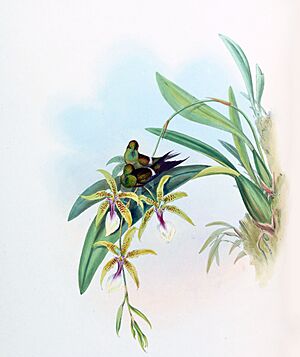Letitia's thorntail facts for kids
Quick facts for kids Letitia's thorntail |
|
|---|---|
 |
|
| Illustration by John Gould | |
| Conservation status | |
| Scientific classification | |
| Genus: |
Discosura
|
| Species: |
letitiae
|
| Synonyms | |
|
Popelairia letitiae (Bourcier & Mulsant, 1852) |
|
The Letitia's thorntail (Discosura letitiae) is a very mysterious and little-known species of hummingbird. It is also called the coppery thorntail. This tiny bird belongs to a group of hummingbirds known as "coquettes." It was named after Letizia del Gallo Roccagiovine, who was the granddaughter of a famous bird expert named Charles Lucien Bonaparte.
Contents
How Scientists Study This Bird
Letitia's thorntail is known from only two old male specimens. These are like samples or examples of the bird. Scientists found these specimens a long time ago. They were said to be from Bolivia, a country in South America. However, sometimes the places written on old specimens are not correct. This means the birds might have come from somewhere else.
Because of this, we don't know much about how these birds live or what their natural home is like. Scientists think their behavior and habitat are probably similar to other thorntails.
For a while, some people thought this bird might not be a real species. They wondered if it was a hybrid, which is a mix of two different species. Others thought it might just be a different version of the racquet-tailed coquette. But a scientist named G.R. Graves studied the specimens carefully. His research showed that Letitia's thorntail is indeed its own unique species. Graves even suggested a new English name for it: Letitia's coquette. He thought its tail feathers looked more like those of coquettes than other thorntails.
What Does Letitia's Thorntail Look Like?
G.R. Graves described the two known specimens of Letitia's thorntail. It's important to remember that the colors of hummingbirds can look different depending on the light. They also change if you look at them from a different angle.
Head and Body Colors
The top of its head, called the crown, is a bright, shiny golden-green. This color smoothly changes to a dark bronze-green on its back. Some parts of its back shimmer with a coppery-bronze color. Below its lower back, there is a thin white stripe. Below this stripe, its rump (the area above its tail) is a coppery red to coppery purple. The feathers covering its upper tail are bronze-green.
Chest and Belly
The chin and upper chest of the bird are golden-green, just like its head. Below the upper chest, there is a soft, light band across its chest. The middle part of its lower chest is bronze-green. This area also has shiny coppery red spots. Its lower belly and sides are a light buffy-white or grayish-white. The area around its vent (where waste leaves the body) is dark gray. The feathers under its tail are dark green with reddish-brown tips.
Tail Feathers
One of the two specimens is missing its central tail feathers. The other specimen has central tail feathers that are bronze-green with wide black tips. The rest of its tail feathers are brownish-black. The tail feathers get longer as you go from the ones closest to its body to the outermost ones. However, the outermost feathers are not super long, like they are in some other thorntail hummingbirds.
What is Its Status?
The IUCN is a big group that studies and protects nature. They have said that Letitia's thorntail is "Data Deficient." This means we don't have enough information about this bird. We don't know how many there are or exactly where they live.
The main reason for this is that we are not sure where the original specimens came from. If they didn't come from Bolivia, then the bird might live somewhere else. It is possible that this species still exists in the wild. It could be living in a place where no one has found it yet. Scientists hope to learn more about this mysterious little hummingbird in the future.


